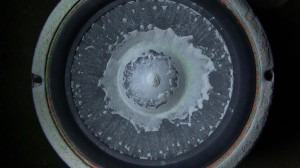
Why settle for your standard music visualiser on your computer when you can create a three-dimensional one simply by filling an old speaker with baking soda? It’s simple, cheap — and hypnotic. “This can damage your speakers, so is best done with an old set,” says artist Zach Walker, who creates visual demos for exhibits and parties. You could also easily damage your hearing, so have ear plugs to hand. Bass-heavy music will throw powder a few metres, so be prepared for a mess. You need: a speaker driver, amplifer, soft material, music source (even a phone will do), baking soda and coloured sand.
Get your set
Use a rubber speaker driver that you’ve removed from an old set, or you can use an intact loudspeaker set if you’re not concerned about getting powder all over it. Be sure to use a driver that is convex, with an outward bump in the centre of it, and not concave, so the sand doesn’t all gather in the bottom.
Set it up
Place the driver on a level surface with soft material under it. This stops the speaker rattling around. Use two objects of the same height, such as old VHS cassettes, to leave a space between the bottom of the speaker and the table, so you have room to connect the speaker wires to an amplifier.
Add colour
Sprinkle baking soda and coloured sand in the driver. Walker recommends Brian Clegg fluorescent sand, which looks great under UV light. But even the baking soda with one extra colour is enough to create mesmerising, trippy cascades up and down the sides of the speaker driver.
Pump it up
Connect your music source to the amplifier, and play around with different types of music: mid-range notes create gentle cascading patterns, bass notes (with a quality subwoofer) produce big percussive bursts. Walker’s favourite tune? “Westwind” by Nina Simone. “It creates amazing patterns,” he says.